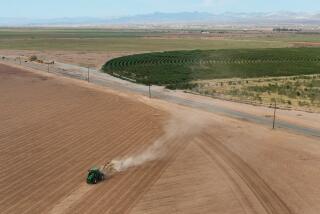Volcano’s Eruption May End Drought, Scientist Predicts
- Share via
The eruption of Mt. Pinatubo in the Philippines may trigger the end of California’s four-year drought, a University of Illinois scientist said Wednesday.
“I am willing to predict it with a very high level of confidence,” said Phillip Handler, the controversial physicist who has made a long study of the links between volcano eruptions and weather. Handler, who was among the first to predict the drought, attributed it to the absence of volcanic activity near the Equator over the past five years.
Handler said that the injection of sulfur dioxide and other gases into the upper atmosphere by the eruption of Mt. Pinatubo will produce a cooling effect near the Equator that will force the storm-bearing jet stream farther south into California next winter. In the past four winters, the jet stream has flowed primarily over Washington and Oregon, bringing storms to those states and bypassing California.
Reaction to Handler’s prediction ranged from cautious hope to serious doubt.
“I would support that estimate . . . but it is still an untested theory and I would regard this as a test of the theory,” said solar physicist Kenneth Schatten of the National Aeronautics and Space Administration in Greenbelt, Md. “I’d like to see it happen, but I wouldn’t make it (the prediction) so definite.”
Other researchers were less sanguine. “I know of no reason to expect long-term drought to be related to volcanic eruptions,” said climatologist Allan Robock of the University of Maryland. The drought was simply due to “natural variability in climate,” he said.
Robock noted, however, that the injection of sulfur dioxide into the stratosphere could produce a global cooling effect for the next year or so. “That happened after the (April 1982) eruption of El Chichon in Mexico,” he said. After that eruption, solar radiation near the Equator was reduced by more than 7.7% for many months. “But we don’t know yet how much sulfur dioxide has been released” by Mt. Pinatubo, he said.
California state climatologist Bill Mark said that “we don’t know enough about it even to comment. . . . But sooner or later, we’re going to have some rainfall and people are going to be coming out of the woodwork saying, ‘I told you so.’ ”
But Mark also voiced a sentiment that was shared by most researchers: “God, I hope he’s right!” But by studying historical records, Handler has linked volcanic activity near the Equator to a variety of events, including water levels in the Great Salt Lake and Lake Michigan, corn yields in the Midwest, the colonization of Greenland, the “little ice age” that afflicted Europe in the middle of the millennium and even the disappearance of the Mesa Verde Indians in the Southwest and the Kahoki Indians in Illinois.
He is also one of the few to have predicted the continuing drought in California and the return of rainfall to the drought-stricken Sahel Desert in North Africa in 1988.
But the problem, said climate researcher Daniel Cayan of the Scripps Institution of Oceanography in La Jolla, is that “there haven’t been a whole lot of volcanic events to test regional weather conditions. . . . It’s certainly an appealing notion, but from my experience, there are no easy answers and no sure-fire predictors. I would be very happy if he is right, but even if it turns out that we have modest to heavy precipitation, that’s not proof of a volcanic influence.”
Furthermore, Cayan said, “There are a lot of caveats and a lot of opportunity for the atmosphere to behave in its own whimsical fashion.”
More to Read
Sign up for Essential California
The most important California stories and recommendations in your inbox every morning.
You may occasionally receive promotional content from the Los Angeles Times.










